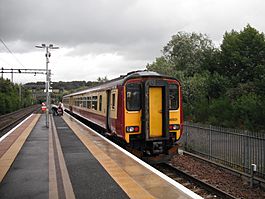Maryhill Line facts for kids
Quick facts for kids Maryhill Line |
|
|---|---|

A Class 156 train at Anniesland, the end of the Maryhill Line
|
|
| Overview | |
| Owner | Network Rail |
| Locale | Glasgow Scotland |
| Stations | 7 |
| Service | |
| System | National Rail |
| Operator(s) | ScotRail |
| Rolling stock | Class 156, Class 158, Class 170 |
| Technical | |
| Track gauge | 4 ft 8 1⁄2 in (1,435 mm) |
The Maryhill Line is a train route that connects different parts of Glasgow, Scotland. It runs from central Glasgow to Anniesland, passing through an area called Maryhill. This line is part of the public transport system managed by the Strathclyde Partnership for Transport (SPT), which helps people travel around the area.
The part of the line between Glasgow and Maryhill is also used by the West Highland Line, which is a famous route. This section of the Maryhill Line was reopened for local passenger trains in 1993. British Rail and the Strathclyde Passenger Transport Executive (another transport group) worked together to reopen it. Local trains stopped running here in the early 1960s. However, the line stayed open for longer distance trains to places like Fort William and Oban, and for carrying goods (freight). In 2005, the line was made longer to reach Anniesland. A new station called Kelvindale was also opened in the northwest of the city.
The Maryhill Line serves these train stations:
- Glasgow Queen Street
- Ashfield
- Possilpark and Parkhouse
- Gilshochill
- Summerston
- Maryhill
- Kelvindale
- Anniesland
Contents
History of the Maryhill Line
The Maryhill Line uses parts of older railway lines that existed a long time ago. These old lines helped create the route we see today.
Original Railway Routes
The Maryhill Line follows the paths of these historic railways:
- The Edinburgh and Glasgow Railway: This was used between Glasgow Queen Street and a place called Cowlairs Junction.
- The Glasgow, Dumbarton and Helensburgh Railway: This section runs between Cowlairs Junction and Maryhill Park Junction.
- The Stobcross Railway: This part of the line goes between Maryhill Park Junction and Anniesland.
How the Maryhill Line Works
Trains on the Maryhill Line connect with other important train routes, like the Argyle Line and North Clyde Line, at Anniesland station. Anniesland is where the Maryhill Line ends. At Anniesland, there is a special platform called a bay platform. This platform was built when the line was extended from Maryhill.
Train Movements and Connections
Before 2005, trains ending at Maryhill had to travel empty to Knightswood North Junction. This was near Westerton, where the route joins the North Clyde network. Trains had to reverse direction and change tracks there before going back to Glasgow. This process took several minutes because the train driver had to move to the other end of the train. This slowed down train traffic at a busy junction. By extending the service to Anniesland, more space was made available on the North Clyde route. This allowed more trains to run between the south side of Glasgow and the Milngavie branch. The connection from Maryhill junction to Westerton is still used by trains going to Oban and Mallaig.
In 2015, a new connection was added at Anniesland. This link connects the Maryhill Line to the Glasgow-bound North Clyde Line. It acts as a backup route into Glasgow Queen Street for trains coming from Edinburgh and the North.
Train Types and Electrification
The Maryhill Line is not electrified. This means trains on this line do not use electricity from overhead wires or a third rail. Instead, passenger services are run by ScotRail using special trains called diesel multiple units. These trains run on diesel fuel. The types of trains used are Class 156, Class 158, and Class 170.
Since May 17, 2014, trains have also run on the Maryhill Line on Sundays.

